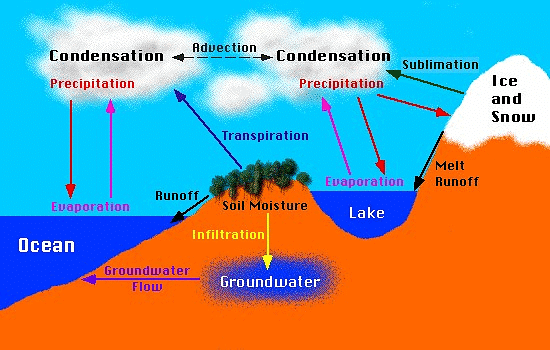Hydrological Cycle | Geography Optional for UPSC PDF Download
- Hydrological cycle is also known as “water cycle” and there is a continuous exchange of water between the atmosphere, the oceans and the continents through the processes of evaporation, transpiration, condensation and precipitation. As the moisture which is present in the atmosphere is taken from water bodies through a process called evaporation and from plants through a process called transpiration (evapotranspiration). Further this evaporation undergoes condensation for the formation of clouds and once after the formation of clouds they fall down in the form of raindrops through precipitation process.
- As the total amount of water vapour present in the atmosphere is constant, to maintain this there should be a proper balance between evapotranspiration and precipitation. And the cycle which maintains this stability is the Hydrological cycle.
- This cycle does not have any starting and ending point, as it leads to continuous circulation of water present on the Earth which causes evolution of the Earth. The factor that assists hydrological cycle or water cycle is the sun, air currents to name a few.
Process of the Water Cycle
Water cycle is completed in various stages or process they are:
Stage I: Evaporation and Transpiration:
In this process energy from the sun heats up the lakes, rivers, oceans, swamps and other water bodies which subsequently increase the temperature of the water present in them. This leads to evaporation of some water into air and the rising air current takes the vapour up in the sky.
Along with this process at the same time plants and trees also lose water to the atmosphere in the form of vapour which rises up in the sky.
Stage II: Condensation
In this process the vapour which rises up gets cooled because of cooler temperature in the surrounding. Because of this water vapour turns back into liquid through the condensation process.
Stage III: Precipitation
In this process there occurs collisions in the cloud particles because of wind movements. Because of this clouds become water laden and they develop into rain bearing clouds and fall back onto the earth’s surface by the process known as precipitation.
They may fall on the Earth in the form of rain, hail, snow or sleet depending upon the temperature conditions.
Stage IV: Runoff and Infiltration
After the precipitation process, precipitated water runs off into oceans, rivers and ground surface or is absorbed into the soil (infiltration).
After going through all these steps water is again ready to go through evaporation and resume earlier stages.
By going through all these processes of hydrological cycle or water cycle water is bringed back to people in the form of fresh water.

Water Vapour in Atmosphere
Volume of water vapour varies in the atmosphere from zero to four per cent by volume of the atmosphere i.e. on an average approx 2% in the atmosphere. Hygrometer is the instrument which is used to measure the amount of water vapour i.e. humidity in the atmosphere.
Significance of Atmospheric Moisture
- Radiation is absorbed by water in both incoming and terrestrial form and by this it plays a crucial role in increasing the heat of the Earth surface.
- The quantity of energy stored in the atmosphere for the development of storms and cyclones is decided by the amount of water vapour present in the atmosphere.
- Rate of human body cooling capacity by the deviation in temperature is influenced by atmospheric moisture.
Humidity
Amount of water vapour present in the air or atmosphere is known as Humidity. The term humidity is explained by relative humidity as a percentage of the maximum amount of water vapor the air can hold at the same temperature.
|
303 videos|635 docs|252 tests
|
FAQs on Hydrological Cycle - Geography Optional for UPSC
| 1. What is the hydrological cycle? |  |
| 2. How does evaporation contribute to the hydrological cycle? |  |
| 3. What is the role of precipitation in the hydrological cycle? |  |
| 4. How does the hydrological cycle impact the availability of freshwater resources? |  |
| 5. What are the consequences of disruptions in the hydrological cycle? |  |





















